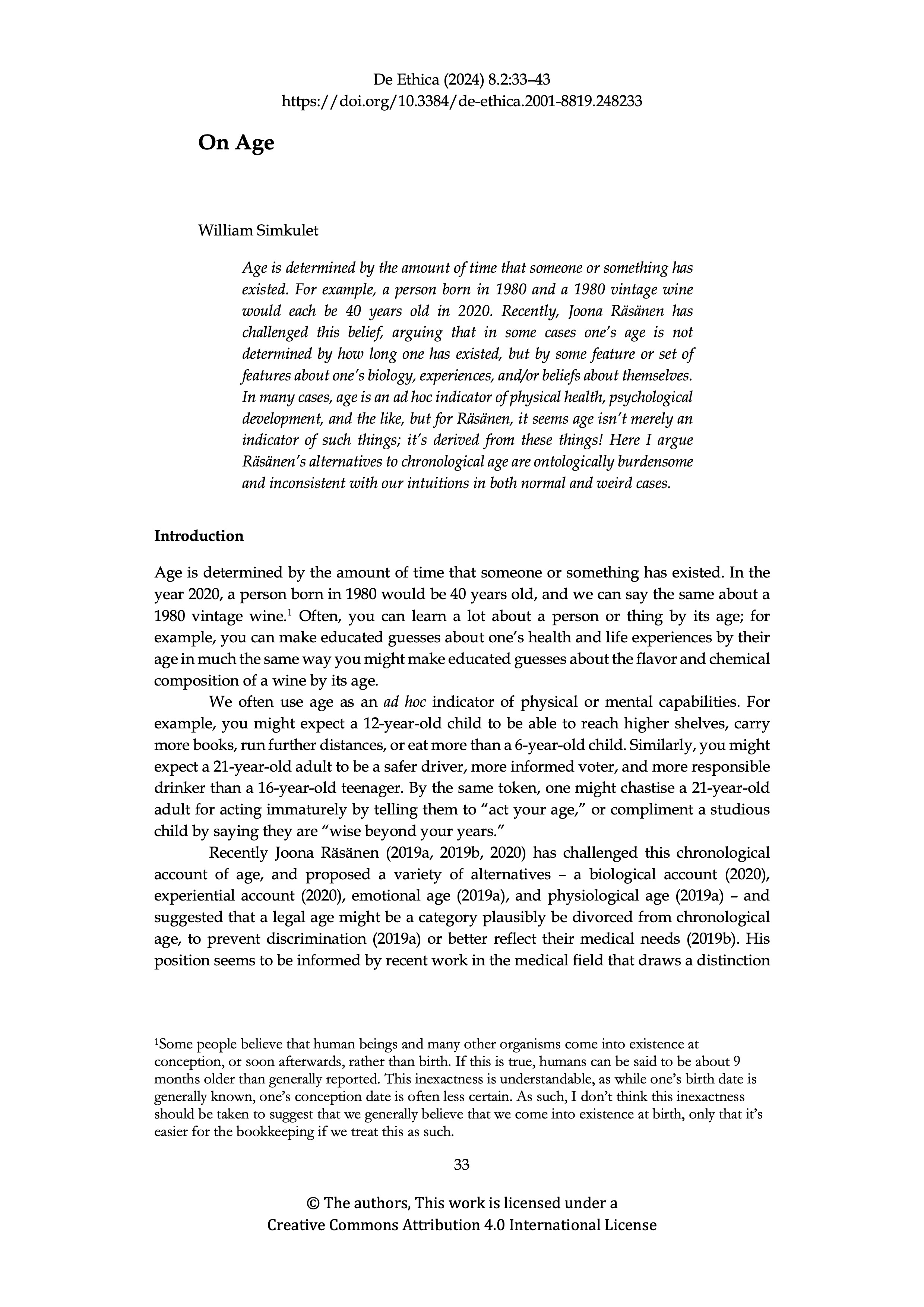On Age
DOI:
https://doi.org/10.3384/de-ethica.2001-8819.248233Keywords:
Age, Aging, Ethics, Rip Van Winkle, Makropulos Case, Metaphorical FallacyAbstract
Age is determined by the amount of time that someone or something has existed. For example, a person born in 1980 and a 1980 vintage wine would each be 40 years old in 2020. Recently, Joona Räsänen has challenged this belief, arguing that in some cases one’s age is not determined by how long one has existed, but by some feature or set of features about one’s biology, experiences, and/or beliefs about themselves. In many cases, age is an ad hoc indicator of physical health, psychological development, and the like, but for Räsänen, it seems age isn’t merely an indicator of such things; it’s derived from these things! Here I argue Räsänen’s alternatives to chronological age are ontologically burdensome and inconsistent with our intuitions in both normal and weird cases.
References
Boonin, D. (2002). A Defense of Abortion (Cambridge Studies in Philosophy and Public Policy). Cambridge: Cambridge University Press. doi:10.1017/CBO9780511610172
Brassington I. (2019) What a Drag it is Getting Old: A Response to Räsänen. J Med Ethics 45(7):467–468.
DeGrazia D. (2017) "The Definition of Death", The Stanford Encyclopedia of Philosophy (Spring 2017 Edition), Edward N. Zalta (ed.), URL = <https://plato.stanford.edu/archives/spr2017/entries/death-definition/>.
Friberg-Fernros. H. (2015) A Critique of Rob Lovering’s Criticism of the Substance View. Bioethics 29(3): 211–216
Friberg-Fernros H. (2018) Hit but not down. The substance view in light of the criticism of Lovering and Simkulet. Bioethics. 00:1–7. https://doi.org/10.1111/bioe. 12450
Goggins WB, Woo J, Sham A, et al. (2005) Frailty Index as a Measure of Biological Age in a Chinese Population. J. Gerontol, 60:1046-1051.
Irving W. 1783-1859. (1963) Rip Van Winkle, and The legend of Sleepy Hollow. New York :Macmillan
Jylhävä J, Pedersen NL & Hägg S. (2017) Biological Age Predictors. EBioMedicine 21:29-36.
Lee P. (2004) The Pro-Life Argument from Substantial Identity: A Defense. Bioethics 18(3): 249-263
Lee P. and George R. P. (2008) The Nature and Basis of Human Dignity. Ratio Juris 21(2): 173–193
Mitnitski AB, Graham JE, Mogilner AJ, et al. (2002) Frailty, fitness and late-life mortality in relation to chronological and biological age. BMC Geriatrics 2:1-8.
Perrault, Charles, and G W. Brenneman. (1889) The Sleeping Beauty in the Wood.
Räsänen J. (2019a) Moral case for legal age change. Journal of Medical Ethics, 45(7):461-464.
Räsänen J. (2019b) Further defence of legal age change. Journal of Medical Ethics, 45(7), 471–472.
Räsänen J. (2020) Age and ageing: What do they mean?. Ratio. 00:1–11. https://doi. org/10.1111/rati.12284
Saad, T.C. (2019) Against the nihilism of ‘legal age change’: response to Räsänen. Journal of Medical Ethics, 45(7):465-466.
Simkulet W. (2019) On Legal Age Change. Journal of Medical Ethics, 45(7):469-470.
Williams, B. (1973) 'The Makropulos Case: Reflections on the Tedium of Immortality', in Bernard Williams, Problems of the Self (Cambridge University Press, 1973), 82-100.
Wilcox, John T. (1989/1993) Nature as Demonic in Thomson’s Defense of Abortion.” In Robert M. Baird and Stuart E. Rosenbaum, eds. The Ethics of Abortion: Pro-Life vs. Pro-Choice, rev. ed. Buffalo,NY: Pranetheus Books 212–225.

Downloads
Published
How to Cite
Issue
Section
License
Copyright (c) 2024 William Simkulet

This work is licensed under a Creative Commons Attribution 4.0 International License.
